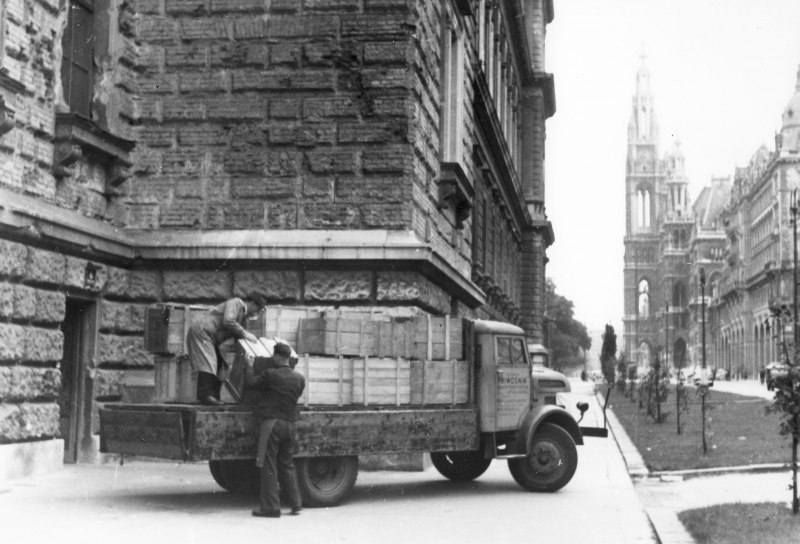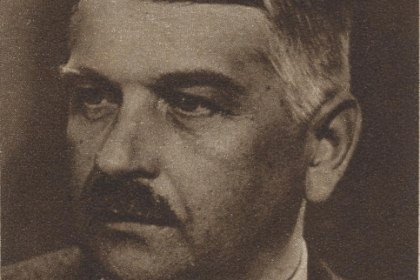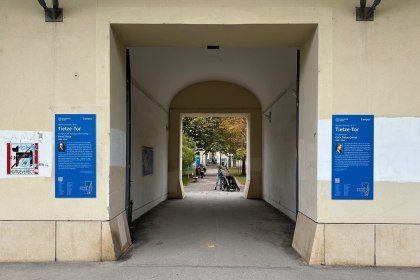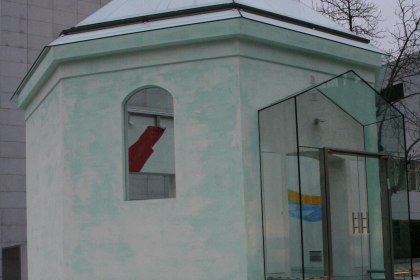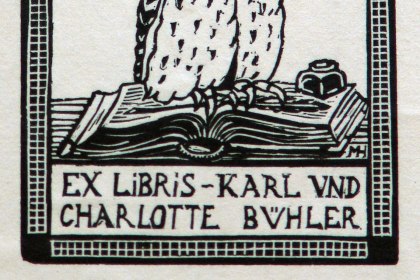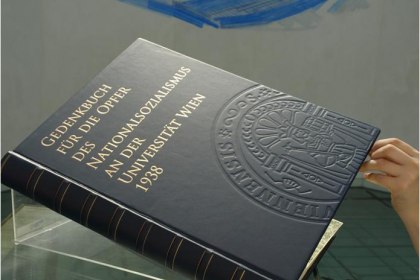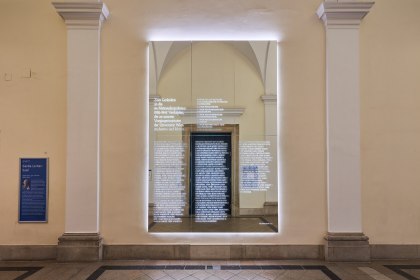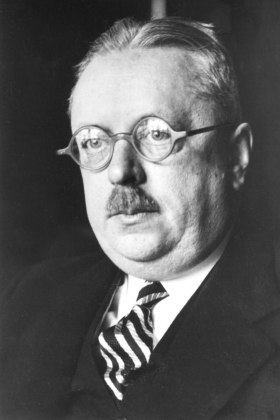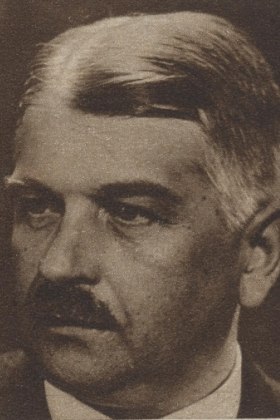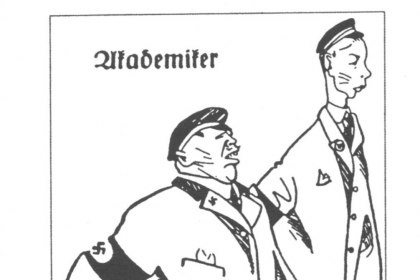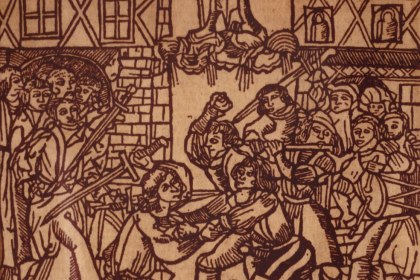Dealing with National Socialism after 1945
Despite massive destruction in the preceding years, the University of Vienna resumed operations immediately after the war. Dealing with the university’s involvement in National Socialism and disciplining members who often were still advocates of Nazi ideology was overcast by the efforts of “reconstruction” and “new beginnings” after 1945. National Socialism (and Austrofascism) had left deep marks that resonated at the university and outside it for years to come.
Reconstruction and restoration
On April 10, 1945, the first Soviet soldiers reached the Viennese university quarter and used the abandoned University Main Building as a dressing station and as stables. On April 25, Ludwig Adamovich sen. was elected as the first post-war rector and on May 29, 1945, lectures were resumed for the summer semester despite the ongoing reconstruction work at the university (the Main Building had been hit by 26 bombs). Students were used as workers for removing debris, for the transport of books and laboratory equipment that had been moved during the war as well as for the restoration of destroyed buildings.
After the end of the Second World War the institution’s involvement in National Socialism was essentially not accounted for. “Denazification” of teachers and students dragged on until the late 1950s and about half of the “belastet” (incriminated) National Socialist professors were able to continue their academic careers after a few years. Only few of the academics expelled in 1938 returned to the university, however. The ministry’s politics instead focused on appointing conservative Catholic teaching staff. How much prominent National Socialist teachers shaped the political environment at the Viennese universities can be seen in the scandal surrounding openly anti-Semitic statements by professor of economic history Taras Borodajkewycz in 1965. However, the public attention it received and the outrage it sparked in the long term led to a first examination of the university’s history during National Socialism.
Accounting for the university’s role in National Socialism
With Kurt Waldheim’s presidential candidacy in 1986 and the “Bedenkjahr” of 1988 (the 50th anniversary of the “Anschluss” to the German Reich) a discourse about the university’s role in National Socialism began within the institution. Important early initiatives in this context were started by dedicated historians and included the lecture series “Die Universität Wien 1938-1945” (1988) and the commemorative inscription for philosopher Moritz Schlick, who was murdered in the university in 1936 (1993). On the occasion of the university’s 625th anniversary in 1990, a first important paper on the expulsion of teachers in 1938 was published, namely the brochure “Vertriebene Intelligenz” (“Displaced Intelligence”).
Around the turn of the millennium the University of Vienna increasingly examined its National Socialist past, for example in the senate project “Untersuchungen zur anatomischen Wissenschaft in Wien 1938-1945” (“Investigations on the anatomical science in Vienna”) and the commemorative plaque in the Arkadenhof (arcaded courtyard) dedicated to the expelled teachers and students of the Faculty of Medicine, which for the first time explicitly acknowledges the university’s co-responsibility. Other activities include several scientific symposiums, projects on the expulsion of students and teachers in 1938, provenance research, lectures and publications, as well as the establishment of the Forum “Zeitgeschichte der Universität Wien” (“Contemporary History of the University of Vienna”) as a coordination office for activities dealing with university history in the 20th and 21st century (2006–2015).
Remembrance and commemoration
National Socialism also became the focus of a critical remembrance culture at the university and stepped into the foreground. In 1998, for example, all 24 passageways of the University of Vienna’s new Campus (the former General Hospital) were dedicated as “Tore der Erinnerung” (“Gates of Remembrance”). Particularly names of women and teachers expelled during National Socialism – formerly underrepresented groups – were chosen for the gates. The still existing Jewish prayer house at the new Campus was inaugurated in 2005 as a place of remembrance and encounter called DENK-MAL Marpe Lanefesch.
The university’s new, reflected attitude towards its involvement in National Socialism could particularly be seen in regard to the historic and artistic contextualization of the German National monument “Siegfriedskopf” in 2006 and its relocation from the Main Building’s aula to the Arkadenhof. The spot vacated by the “Siegfriedskopf” was used for two commemorative alcoves with statements declaring what the university stands for today: remembrance of the victims of National Socialism, “for the freedom of sciences and respect of the human rights” and “against war and violence”. In the course of the rearrangement of the aula in 2006, the installation “Nobelpreis und Universität – ein Gruppenbild mit Fragezeichen” (“Nobel prize and university – a group picture with a question mark”) was also opened. Among other things, it details Julius Wagner-Jauregg’s and Konrad Lorenz’s involvement in National Socialism.
Aside from these university-wide commemoration and remembrance activities, projects from various disciplines were also conducted in this time, such as the decentralized “Denkmal für Ausgegrenzte, Emigrierte und Ermordete des Kunsthistorischen Instituts der Universität Wien 1933/34 | 1938 | 1945” (“Monument for excluded, emigrated and murdered members of the Institute of Art History of the University of Vienna”) in 2008.
Innovations in the context of remembrance also include virtual forms, such as the online “Gedenkbuch für die Opfer des Nationalsozialismus an der Universität Wien 1938” (“Memorial book for the victims of National Socialism at the University of Vienna in 1938”), which was presented in 2009 and is constantly being expanded as a work in progress.
-
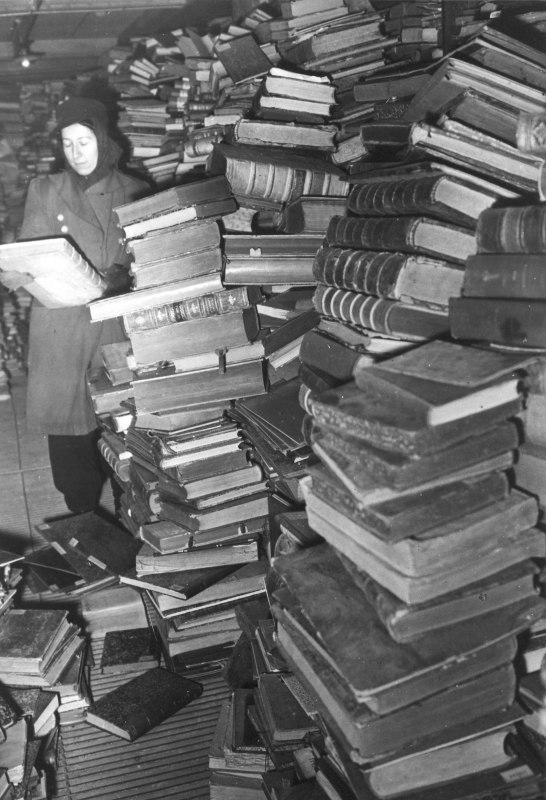
Rückführung der Bücher der Universitätsbibliothek ins Hauptgebäude
-
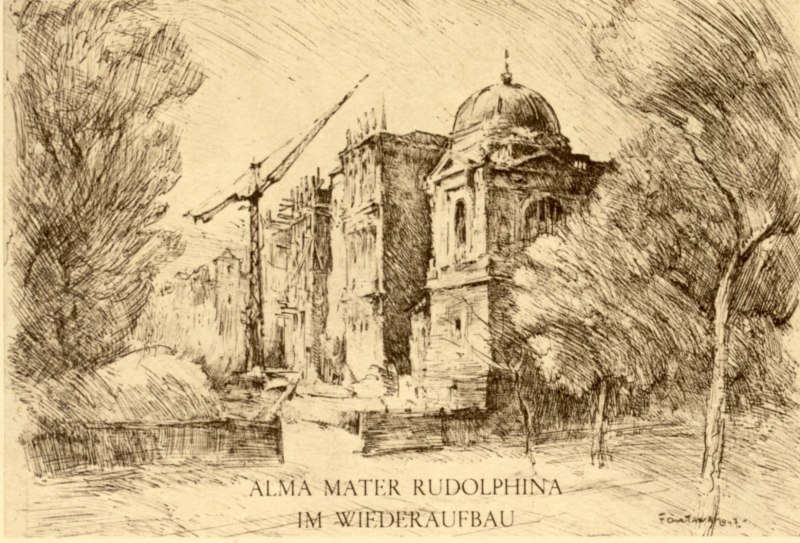
Postkarte als 2-Schilling-Bausteinspende für den Wiederaufbau der Univ. Wien, hrsg. vom Spendenkomitee unter dem Ehrenschutz der Universität Wien
-

Wiederaufbau des Juristentraktes des Hauptgebäudes nach dem Zweiten Weltkrieg, ca. 1946–1951
Zuletzt aktualisiert am 03/05/24
-
The de-Nazification of the professorate at the University of Vienna
1945–1950 -
Gates of Remembrance on the Campus of the University of Vienna
1998 -
DENK-MAL Marpe Lanefesch
1903–2015 -
National Socialist provenance research at the Vienna University Libraries
2004–2015 -
Memorial Book for the Victims of National Socialism at the University of Vienna in 1938
2009–21th Cent. -
Monument “Expelled Historians”
19th.5.2022–21th Cent.
-
Kurt Schubert
4.3.1923–4.2.2007 -
Ludwig Adamovich sen.
30.4.1890–23.9.1955 -
Otto Skrbensky
22.7.1887–29.10.1952 -
Taras Borodajkewycz
1.10.1902–10.1.1984
-
Anti-Semitism at the University of Vienna
1421–2006

